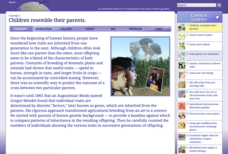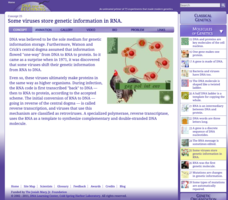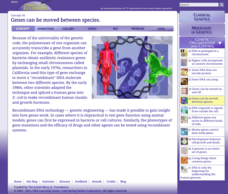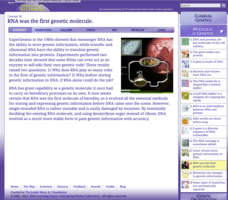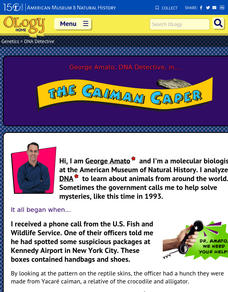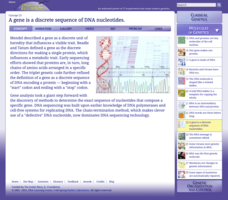Howard Hughes Medical Institute
Central Dogma and Genetic Medicine
Scientists work every day to find solutions to genetic diseases. Scholars learn about the process of gene sequencing, mutations, and the results. They explore genetic diseases and therapies to intervene and help and, through case...
Cold Spring Harbor Laboratory
DNA Words Are Three Letters Long
DNA writes 64 different words but only codes for 20 different amino acids. Budding scientists learn about where each of these numbers come from and why they aren't equal with an online interactive. The resource explains the research, the...
Cold Spring Harbor Laboratory
Children Resemble Their Parents
Gregor Mendel's work revolutionized agriculture from an art to a science. Explore Mendel's work with an interactive lesson that includes animations, video, and practice problems. The instruction describes the early discoveries that...
Cold Spring Harbor Laboratory
Some Viruses Store Genetic Information in RNA
Can a high school program alter the entire course of your life? David Baltimore and Howard Temin participated in high school programs working in research laboratories and went on to win the 1975 Nobel Prize. Learn about these two...
Howard Hughes Medical Institute
Using DNA to Trace Human Migration
Can scientists trace all humans back to a small region in Africa? An intriguing lesson turns back time to reveal artifacts leading scientists to believe human life originated in Africa and dispersed from there.
Cold Spring Harbor Laboratory
Genes Can Be Moved Between Species
Biotechnology changes lives every day, but how did it all start? Learn about Cohen and Boyer's technique for recombinant DNA and the founding of this new scientific study. Then, scholars use the online interactive to discover how Hanahan...
Cold Spring Harbor Laboratory
RNA Was the First Genetic Molecule
Can organic molecules come from a pre-biotic environment? Stanley Lloyd Miller proved it is possible when exactly the right conditions exist. Learn about his experiment and the other experiments later building off of it that changed the...
American Museum of Natural History
DNA Detective
Match up the DNA code. Pupils read the website from the American Museum of Natural History about how DNA can determine whether a skin is from a particular type of reptile. Using the same technique, learners match up products with the...
Cold Spring Harbor Laboratory
Genes Can Be Turned On and Off
Regulations exist in many places from business to schools, but what about in our genes? Learn about gene regulation with an online interactive. It uses an animation to introduce the topic, many photographs of the scientists best known...
Cold Spring Harbor Laboratory
RNA Is an Intermediary Between DNA and Protein
For years, scientists believed tRNA was junk left over from larger RNA. Three scientists used different approaches to prove tRNA actually exists as the connection between DNA and protein. Learn about their experiments, their lives, and...
Cold Spring Harbor Laboratory
Living Things Share Common Genes
Everything evolved from a common ancestor, but how did modern plants and animals develop so many more genes? Scholars use an online interactive to learn about the process. They begin to understand common genes with an animation, multiple...
Cold Spring Harbor Laboratory
Some DNA Does Not Encode Protein
Roy John Britten easily earned a PhD in nuclear physics—but he found painting with water colors too difficult. Young scientists learn about Britten's life, career, and research with an online interactive. They read a biography, view...
Cold Spring Harbor Laboratory
A Gene Is a Discrete Sequence of DNA Nucleotides
Frederick Sanger won two Nobel prizes for protein sequencing and DNA sequencing. Young scientists learn about Dr. Sanger's research and amazing discoveries. They read an article and a biography, view videos and animations, and apply...
Curated OER
Passive in Context
In this tense worksheet, students read the sentences or phrases and choose which tense they are written in. Students complete 10 problems total.
PBS
Pbs Teachers:build a Family Tree (Men Only)
Understand DNA sequences and the Y chromosome. Solve a genealogical puzzle using the power of reasoning and understanding of DNA, and complete the a male family tree using DNA information from the Y chromosome of three fictitious...


